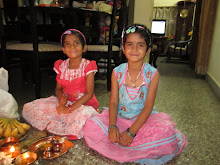These are some photographs of the Raghavendra Swamy Matha in Kalyani Gardens
 |
| A sole bulb illuminates the face of Rayaru which can be seen evolving. |
 |
| The image of Rayaru is garlanded with flowers. |
 |
| The image is now encased within a wooden frame with glass. |
 |
| One can see the image slowly taking shape |
 |
| The entrance to the Kalyani Rayara Matha |
 |
| Another view of the entrance of the Rayara Matha |
There are scores of Raghavendra Swamy Mathas in Bangalore
One such Matha and it is also among the oldest is the one at Kalyani Gardens
The Kalyani Raghavendra Swamy
Matha it is located next to the Madhwa Patashala and both are near Vidyapeetha.
The Matha has been drawing
visitors and devotees because of a unique phenomenon. An image of Raghavendra
Swamy is manifesting itself on the left outer wall of the Prakara housing the
Brindavana of Raghavendra Swamy.
The image is slowly becoming
more and more visible each day and the outlines of the face with eyes and nose
can clearly been seen. There is no doubt that the image on a wall is that of
our beloved Rayaru.
Till a few days ago, the
image was left as it is on the wall. When the image was touched, the concrete
surface was smooth than the rest of the wall. Many devotees and the priests told us that when they reverentially touched the image, it felt soft.
The image is developing by
the day and as many people were touching it, the temple management decided to
protect it by encasing it in a wooden frame with a glass front.
So if you go to the Matha,
you can see the outlines of Rayaru through the glass. This is perhaps the first
time in Bangalore
The Kalyani Rayaru Matha is
one of the oldest in Bangalore
It was Mrs. Seethamma and Ananda Tirthachar Kalyani who had built
the Temple, performed Pratishtha and Utsarga of Raghavendra Swamy at this very place (where
the Brindavana is located) in 1942-43.
Thereafter, Mrs. Seethamma
and Mr. Kalyani were functioning as Dharma Karthas of the temple. In 1953,
the whole establishment was transferred to Mr. A.V. Krishna Murthy. However, in
1957 Mr. A.V. Krishna Murthy re-transferred the Temple Mutt and Pathasala to Mrs. Seethamma Kalyani
requesting her to manage the Temple poojas
The Kalyani Gardens
The temple of Raghavendra Swamy
The temple is located just
off a 30 feet road which is open to both way traffic. Since there are several
industries, business and commercial establishments in and around the vicinity,
the road has traffic. All the above photos were taken by us and they depict the image of Rayaru. The last two photos are that of the Kalyani Rayara Matha Brindavana.




